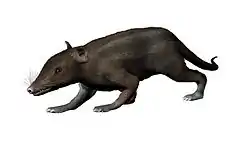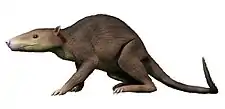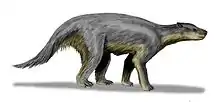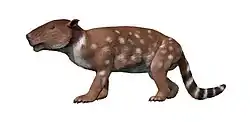Ukhaatherium
Ukhaatherium is a now extinct species of mammal that lived during the upper Cretaceous about 84 to 72 million years ago in today's East Asia. It is known above all from Ukhaa Tolgod, where it alone is occupied by eight individuals, six of them completely. In general, Ukhaatherium weighing about 32 g was quite small and resembled today's insect eaters. In addition, there were still some original skeletal features.
| Ukhaatherium | |
|---|---|
| Scientific classification | |
| Kingdom: | |
| Phylum: | |
| Class: | |
| Order: | |
| Genus: | Ukhaatherium |
| Type species | |
| Ukhaatherium nessovi Novacek, Rougier, Wible, McKenna, Dashzeveg & Horovitz, 1997 | |
Fossil findings
Since the year 1990 joint expeditions of the American Museum of Natural History and the Mongolian Academy of Sciences took place in the Gobi desert of southern Mongolia, in order to investigate Upper Cretaceous and Tertiary vertebrates. Alone more than 500 skulls of mammals were discovered at the Ukhaa Tolgod fossil field in the Nemegt Basin discovered in 1993, together with outstanding fossil dinosaurs - both skeletons, eggs and embryos -, birds and lizards. The discovery of two mammalian species from the early stages of the development of Eutheria, including the first known one from Ukhaatherium and another from Zalambdalestes, were prominent. These originate from the Djadochta Formation, which is dated to Campanian about 84 to 72 million years ago.
Systematics
Ukhaatherium is a genus from the family of the Asioryctitheria, which lived in the late Cretaceous. Asioryctes, both together form the subfamily of the Asioryctinae, while Kennalestes stands somewhat outside this group. These early mammals are characterized by the presence of four premolars.





